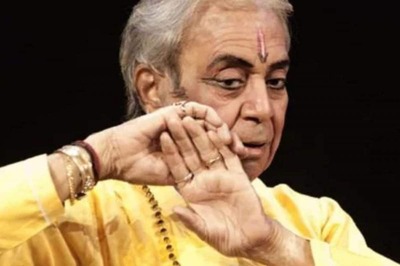
views
The Arabian Sea – stretching across an area of about 38,62,000 sq km with a maximum width of approximately 2,400 km and depth of 4,652 m – is a hub of transnational organised crime at sea, including drug trafficking; trafficking in persons; smuggling of migrants; illegal, unreported and unregulated fishing; and asymmetric threats at or from the sea.
Similarly, opioids produced in Central Asian nations are loaded onto dhows and transported through the Arabian Sea towards the west and east. In the east, they transit through South Asian countries, including India, Sri Lanka and the Maldives, to then reach further destinations. This is known as the ‘Southern Route’, a well-established maritime path for opioid smuggling in the Indian Ocean Region, extending to Angola, Comoros, Djibouti, Kenya, Madagascar, Mauritius, Mozambique, Namibia, Seychelles and Tanzania.
‘Operation Samudragupt’, jointly conducted by the Narcotics Control Bureau (NCB) and the Indian Navy, has successfully interdicted a massive consignment of 2,700 kg of narcotics worth Rs 15,000 crore in the Arabian Sea off the coast of Kochi and apprehended a suspected Pakistani national. In all, 134 sacks of suspected methamphetamine, a boat and other items salvaged from the ship were brought to Kochi by the navy and handed over to the NCB, which in a statement, said the drug cache had started on a “mother ship” – a large vessel that distributes narcotics to several boats during its journey – from the Makran coast around Pakistan and Iran.
Drug seizures in the Arabian Sea are nothing new. On January 3 this year, it was disclosed that a French warship seized illegal drugs (worth a total estimated US street value of $24 million) from a fishing vessel transiting international waters in the North Arabian Sea, on December 27, 2022. French Marine Nationale frigate FS Guépratte (F714) was patrolling regional waters in support of the combined task force (CTF) 150 when it seized 3,492 kg of hashish and 472 kg of heroin from a fishing vessel.
Led by the Royal Saudi Navy, CTF 150 is one of four task forces organised under the Combined Maritime Forces (CMF) – the largest international naval partnership in the world consisting of 34 member-nations. The capture of the cargo comes amid wider concerns about the spread of the narcotics trade in the Gulf Arab region, with governments working together in an attempt to stem smuggling.
On February 25, the US Coast Guard seized $20 million worth of illegal drugs in the Arabian Sea during a routine patrol. The Sentinel-class cutter John Scheuerman intercepted a fishing vessel in international waters carrying four mariners, who were transporting more than 3,500 pounds (over 1,500 kg) of narcotics.
A frigate from the United Kingdom Royal Navy seized $6 million worth of hashish from a fishing vessel transiting the Arabian Sea, in May. The HMS Lancaster (F 229) was operating in support of CTF 150 when it discovered 3,000 kg of hashish on the smuggling vessel. The seizure took place the same day the US Coast Guard confiscated large quantities of methamphetamines and heroin from another fishing vessel while patrolling the Gulf of Oman under CTF 150.
Currently led by the UK, efforts by the CTF 150 in the Middle East this year have resulted in drug seizures worth a combined estimated US street value of more than $250 million. France’s Abu Dhabi-based naval command for the region suggested that the shipment, with an estimated value of 50M EUR, may have been partially bound for Europe.
Operation Samudragupt is the third major seizure by the NCB of maritime trafficking of drugs through the southern route over the past year and a half. The first seizure in the operation was made in February 2022, when a joint team of the NCB and navy seized 529 kg of hashish, 221 kg of methamphetamine and 13 kg of heroin from the high seas off the coast of Gujarat, all sourced from Balochistan (a region in Pakistan) and Afghanistan.
Subsequently, an Iranian boat was intercepted off the coast of Kerala in a joint operation by NCB and navy in October 2022 and a total of 200 kg of high-grade heroin, also sourced from Afghanistan, was seized and six Iranian drug traffickers were arrested.
The identity of the drug lords operating behind such mammoth seizures is still a matter of speculation. The US recently released drug lord Haji Bashir Noorzai in a prisoner swap deal with the Taliban. Noorzai is referred to as the “Pablo Escobar of Asia” and he spent over 17 years in US captivity but his release has been seen as a matter of concern by security agencies of many countries, including India. It was believed that Noorzai’s release would lead to a spike in smuggling of drugs across borders.
Another name that has emerged in connection with Operation Samudragupt is that of Haji Salim alias Haji Ali. It is believed that Haji Ali is living in Pakistan and is running his massive drug empire extending to half of the world from his safe haven in Pakistan, and all the big drug consignments caught in India after 2016, is seen as his handiwork. He specialises in smuggling drugs through the sea and has built a good network in the Arabian Sea. He has a penchant for using fancy code words and numerals like ‘Scorpion’, Rolex 55 seals, in addition to 777, 555, 999 and so on.
The heavy illicit narcotics trade in the Arabian Sea and its extensions in the Gulf region, has created a lot of discord. Yemeni influencer Mohammed Mahmoud Hatemhas accused Iran and its proxies of proliferating narcotics in the Gulf Arab region “to destroy future generations”. Some reports have suggested that a vast manufacturing and distribution network for a variety of narcotic drugs, including Captagon, is allegedly directed by associates of Syrian President Bashar Al-Assad to fill government coffers amid the country’s economic collapse. Many of the drug consignments are also intended for Australia, where methamphetamine commands a lucrative price.
The production of illicit narcotics in low-intensity conflict environments remains a serious concern for many nations. Afghanistan is a solid example where the intersection of crime, narcotics production and insurgency has successfully thwarted stabilisation and security efforts. Despite efforts of many nations, the political, economic and conflict related factors that facilitate the narcotics industry and forges cooperation between drug trafficking organisations and insurgent movements, has still not been deciphered in its entirety.
(The author is IRS (retd), PhD (narcotics), former director general, National Academy of Customs, Indirect Taxes & Narcotics (NACIN). The views expressed in this article are those of the author and do not represent the stand of this publication)



















Comments
0 comment